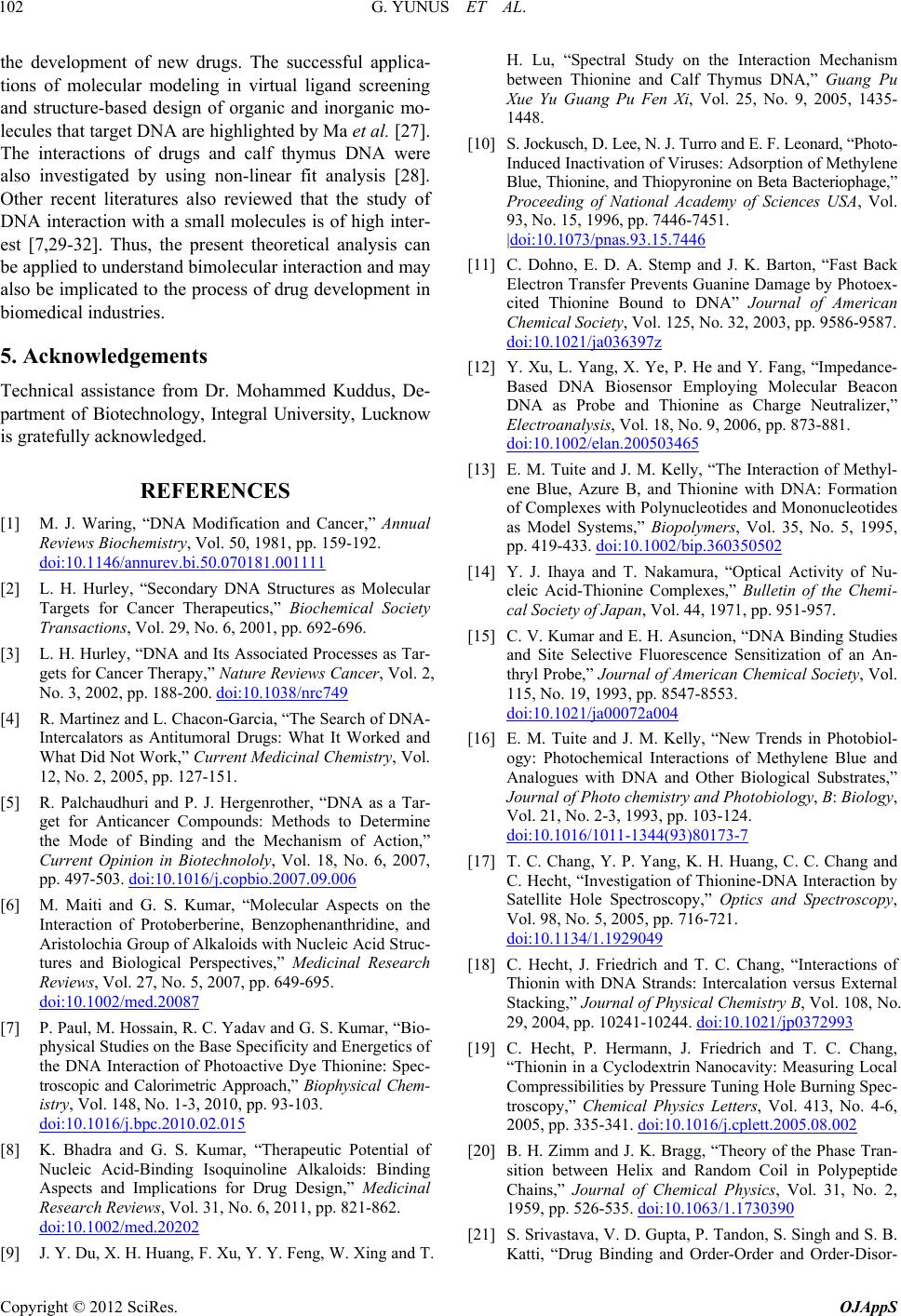
G. YUNUS ET AL.
102
the development of new drugs. The successful applica-
tions of molecular modeling in virtual ligand screening
and structure-based design of organic and inorganic mo-
lecules that target DNA are highlighted by Ma et al. [27].
The interactions of drugs and calf thymus DNA were
also investigated by using non-linear fit analysis [28].
Other recent literatures also reviewed that the study of
DNA interaction with a small molecules is of high inter-
est [7,29-32]. Thus, the present theoretical analysis can
be applied to understand bimolecular interaction and may
also be implicated to the process of drug development in
biomedical industries.
5. Acknowledgements
Technical assistance from Dr. Mohammed Kuddus, De-
partment of Biotechnology, Integral University, Lucknow
is gratefully acknowledged.
REFERENCES
[1] M. J. Waring, “DNA Modification and Cancer,” Annual
Reviews Biochemistry, Vol. 50, 1981, pp. 159-192.
doi:10.1146/annurev.bi.50.070181.001111
[2] L. H. Hurley, “Secondary DNA Structures as Molecular
Targets for Cancer Therapeutics,” Biochemical Society
Transactions, Vol. 29, No. 6, 2001, pp. 692-696.
[3] L. H. Hurley, “DNA and Its Associated Processes as Tar-
gets for Cancer Therapy,” Nature Reviews Cancer, Vol. 2,
No. 3, 2002, pp. 188-200. doi:10.1038/nrc749
[4] R. Martinez and L. Chacon-Garcia, “The Search of DNA-
Intercalators as Antitumoral Drugs: What It Worked and
What Did Not Work,” Current Medicinal Chemistry, Vol.
12, No. 2, 2005, pp. 127-151.
[5] R. Palchaudhuri and P. J. Hergenrother, “DNA as a Tar-
get for Anticancer Compounds: Methods to Determine
the Mode of Binding and the Mechanism of Action,”
Current Opinion in Biotechnololy, Vol. 18, No. 6, 2007,
pp. 497-503. doi:10.1016/j.copbio.2007.09.006
[6] M. Maiti and G. S. Kumar, “Molecular Aspects on the
Interaction of Protoberberine, Benzophenanthridine, and
Aristolochia Group of Alkaloids with Nucleic Acid Struc-
tures and Biological Perspectives,” Medicinal Research
Reviews, Vol. 27, No. 5, 2007, pp. 649-695.
doi:10.1002/med.20087
[7] P. Paul, M. Hossain, R. C. Yadav and G. S. Kumar, “Bio-
physical Studies on the Base Specificity and Energetics of
the DNA Interaction of Photoactive Dye Thionine: Spec-
troscopic and Calorimetric Approach,” Biophysical Chem-
istry, Vol. 148, No. 1-3, 2010, pp. 93-103.
doi:10.1016/j.bpc.2010.02.015
[8] K. Bhadra and G. S. Kumar, “Therapeutic Potential of
Nucleic Acid-Binding Isoquinoline Alkaloids: Binding
Aspects and Implications for Drug Design,” Medicinal
Research Reviews, Vol. 31, No. 6, 2011, pp. 821-862.
doi:10.1002/med.20202
[9] J. Y. Du, X. H. Huang, F. Xu, Y. Y. Feng, W. Xing and T.
H. Lu, “Spectral Study on the Interaction Mechanism
between Thionine and Calf Thymus DNA,” Guang Pu
Xue Yu Guang Pu Fen Xi, Vol. 25, No. 9, 2005, 1435-
1448.
[10] S. Jockusch, D. Lee, N. J. Turro and E. F. Leonard, “Photo-
Induced Inactivation of Viruses: Adsorption of Methylene
Blue, Thionine, and Thiopyronine on Beta Bacteriophage,”
Proceeding of National Academy of Sciences USA, Vol.
93, No. 15, 1996, pp. 7446-7451.
|doi:10.1073/pnas.93.15.7446
[11] C. Dohno, E. D. A. Stemp and J. K. Barton, “Fast Back
Electron Transfer Prevents Guanine Damage by Photoex-
cited Thionine Bound to DNA” Journal of American
Chemical Society, Vol. 125, No. 32, 2003, pp. 9586-9587.
doi:10.1021/ja036397z
[12] Y. Xu, L. Yang, X. Ye, P. He and Y. Fang, “Impedance-
Based DNA Biosensor Employing Molecular Beacon
DNA as Probe and Thionine as Charge Neutralizer,”
Electroanalysis, Vol. 18, No. 9, 2006, pp. 873-881.
doi:10.1002/elan.200503465
[13] E. M. Tuite and J. M. Kelly, “The Interaction of Methyl-
ene Blue, Azure B, and Thionine with DNA: Formation
of Complexes with Polynucleotides and Mononucleotides
as Model Systems,” Biopolymers, Vol. 35, No. 5, 1995,
pp. 419-433. doi:10.1002/bip.360350502
[14] Y. J. Ihaya and T. Nakamura, “Optical Activity of Nu-
cleic Acid-Thionine Complexes,” Bulletin of the Chemi-
cal Society of Japan, Vol. 44, 1971, pp. 951-957.
[15] C. V. Kumar and E. H. Asuncion, “DNA Binding Studies
and Site Selective Fluorescence Sensitization of an An-
thryl Probe,” Journal of American Chemical Society, Vol.
115, No. 19, 1993, pp. 8547-8553.
doi:10.1021/ja00072a004
[16] E. M. Tuite and J. M. Kelly, “New Trends in Photobiol-
ogy: Photochemical Interactions of Methylene Blue and
Analogues with DNA and Other Biological Substrates,”
Journal of Photo chemistry and Photobiology, B: Biology,
Vol. 21, No. 2-3, 1993, pp. 103-124.
doi:10.1016/1011-1344(93)80173-7
[17] T. C. Chang, Y. P. Yang, K. H. Huang, C. C. Chang and
C. Hecht, “Investigation of Thionine-DNA Interaction by
Satellite Hole Spectroscopy,” Optics and Spectroscopy,
Vol. 98, No. 5, 2005, pp. 716-721.
doi:10.1134/1.1929049
[18] C. Hecht, J. Friedrich and T. C. Chang, “Interactions of
Thionin with DNA Strands: Intercalation versus External
Stacking,” Journal of Physical Chemistry B, Vol. 108, No.
29, 2004, pp. 10241-10244. doi:10.1021/jp0372993
[19] C. Hecht, P. Hermann, J. Friedrich and T. C. Chang,
“Thionin in a Cyclodextrin Nanocavity: Measuring Local
Compressibilities by Pressure Tuning Hole Burning Spec-
troscopy,” Chemical Physics Letters, Vol. 413, No. 4-6,
2005, pp. 335-341. doi:10.1016/j.cplett.2005.08.002
[20] B. H. Zimm and J. K. Bragg, “Theory of the Phase Tran-
sition between Helix and Random Coil in Polypeptide
Chains,” Journal of Chemical Physics, Vol. 31, No. 2,
1959, pp. 526-535. doi:10.1063/1.1730390
[21] S. Srivastava, V. D. Gupta, P. Tandon, S. Singh and S. B.
Katti, “Drug Binding and Order-Order and Order-Disor-
Copyright © 2012 SciRes. OJAppS